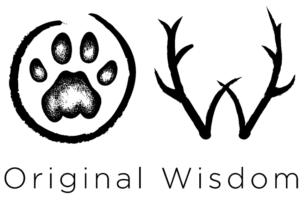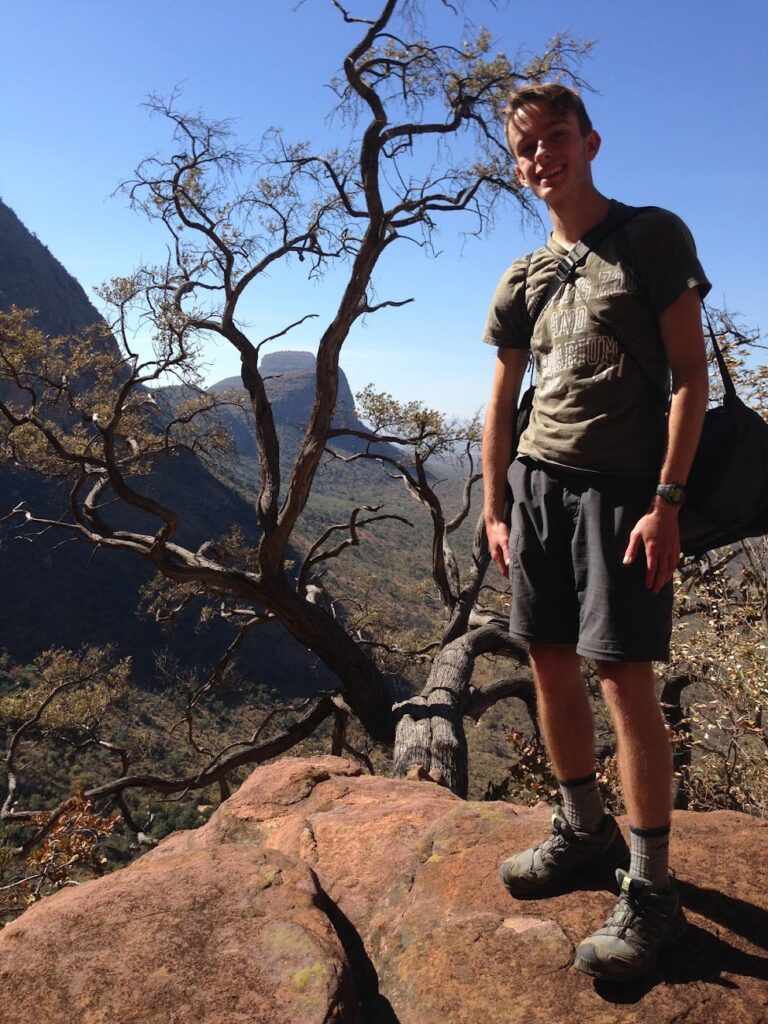Learning to sit in nature – Hopkinton/Bow Student Blog #8
The following blog post is created by a Hopkinton/Bow High School student from New Hampshire, who is on program with Original Wisdom, partnering with Nature Guide Training, on a 3-week South African Ecology & Culture program at Djuma Game reserve in the Sabi Sands region of the Greater Kruger Area (July 2015). In addition to exposure to ecology and culture, we have sponsored a local South African student on scholarship for the entire program (see Blog 3# Interview with Mhlavasi) and will attend 2 days at Mhlavasi’s school, Acorns to Oaks, where our students interact with the local students and help to teach them some basic skills in spatial thinking and use of Geographic Information Systems (GIS) to create online maps and stories with a spatial component. Our overall goals include facilitating connections with self, others, and the natural world.
Michelle Neal
July 10, 2015
Day 9
These past days of tracking, trailing, and traversing have consumed our minds with blissful chaos. It’s been incredible and epic, but it’s equally important to step away from the stimulation and practice silence, awareness, reflection and gratitude. Hence, on this lovely July morning, we practiced our first “sit spot” in the African bush: My group was guided through the process by Scott, and Kersey guided the other group. Of course, because it is the African bush, Kersey and Diana carried rifles and patrolled each area we were in while we sat.
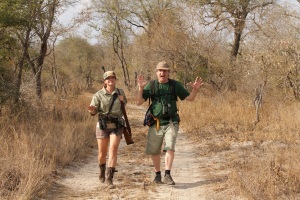
Sit spots have been practiced for as long as people have been sitting in nature and observing their surroundings, although they were probably not called “sit spots.” The name sit spot comes from Jon Young and the Wilderness Awareness School. Here’s how they work: Find a comfortable location in nature that is convenient to go to on a regular basis, visit there as often as possible and sit quietly, without technology, and observe your surroundings, letting your thoughts pass through your mind and bringing your awareness back to your senses and what is happening around you. 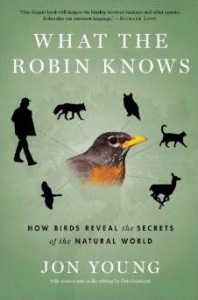 We also practiced a bit of “bird language,” or how listening to the vocalizations of birds (and other animals) can help us to know what other animals are moving through the area – this is based on the principle that animals make alarm calls that are different from normal, happy, sounds, when a predator disturbs them. Of course, bird and animal language has also been practiced by people for thousands of years, especially here in Africa where birds like oxpeckers often tell us when a large animal like a buffalo or rhino is hiding in the bush, or a snake is climbing a tree to rob a nest – but you can learn more about it in the book, What the Robin Knows, How Birds Reveal the Secrets of the Natural World, by Jon Young (Wilderness Awareness School, WA.) and with science and audio editing by Dan Gardoqui (White Pine Programs, ME.). Even though we didn’t get to formally practice together as a group much on this trip, we learned the basic principles and how to learn more about it to continue the practice back home. Our instructors stressed the value of many short visits to a convenient sit spot rather than an occasional long visit to an beautiful spot far away: we would develop bird language and sit spot skills more quickly by visiting a convenient spot for a half an hour every day, at different times of the day and night, than by practicing during a huge block of time once a week or month.
We also practiced a bit of “bird language,” or how listening to the vocalizations of birds (and other animals) can help us to know what other animals are moving through the area – this is based on the principle that animals make alarm calls that are different from normal, happy, sounds, when a predator disturbs them. Of course, bird and animal language has also been practiced by people for thousands of years, especially here in Africa where birds like oxpeckers often tell us when a large animal like a buffalo or rhino is hiding in the bush, or a snake is climbing a tree to rob a nest – but you can learn more about it in the book, What the Robin Knows, How Birds Reveal the Secrets of the Natural World, by Jon Young (Wilderness Awareness School, WA.) and with science and audio editing by Dan Gardoqui (White Pine Programs, ME.). Even though we didn’t get to formally practice together as a group much on this trip, we learned the basic principles and how to learn more about it to continue the practice back home. Our instructors stressed the value of many short visits to a convenient sit spot rather than an occasional long visit to an beautiful spot far away: we would develop bird language and sit spot skills more quickly by visiting a convenient spot for a half an hour every day, at different times of the day and night, than by practicing during a huge block of time once a week or month.
This particular sit spot was a little unusual because we had two tasks to complete in addition to paying attention to our senses. By pay attention to our senses, I mean: notice wind directions, sounds, smells, jets overhead, angle of sunlight, location and body language of individual birds, the comfort or discomfort in our own bodies as we sat on the earth, etc. Task number one during our hour of awareness was to construct a map of our surroundings; we drew in the topography, tracks and sign, vegetation, and even the possible territories of individual birds. Our second task was to think about the purpose of what we would be doing in the Acorns to Oaks school in the next couple of days – interacting with the students and introducing them to spatial thinking. We were asked to think about the question: how will spatial thinking affect our future, and what is its potential for students at Acorns to Oaks?
Our reflections included: Declan and myself mentioned its ability to make us “more conscious of my surroundings” and to help us to develop “mindful decisions.” As far as the students at Acorns to Oaks, whom we will be meeting this Monday and Tuesday, Gabby hopes they’ll develop a greater “respect for the land.” I hope spatial thinking will provide tangible evidence and practical skills that will enhance all of our abilities to have a positive impact in our communities, and in the world. Naina mentioned that, to her, spatial thinking is a form of geographical education that has potential to lessen prejudice and open peoples’ eyes to our world’s human and non-human diversity. In Kersey’s group, she reported that students first appreciated the little birds, “checking them out” with strident vocalizations at first that subsided to mild agitation after a little while – with the birds getting used to these strange humans sitting literally inside their homes. They also heard hippos calling far, away, and the “Ngatutu,” or Southern ground hornbills calling to each other – whose name comes from the sound they make, a booming and repeated “In-ga-tu-tu.” A big nyala bull walked through the area peacefully, noticed them, and moved away. Delanie and Zach mentioned that they had almost fallen asleep! Our instructors received this with appreciation rather than dismay because it indicated a deep sense of comfort at being in close contact with the earth, rather than a sense of discomfort at the thought of being dirty and coming into contact with occasional insects. In the end, we all agreed that awareness and spatial thinking can be applied to numerous life skills, and drawing a map of our location helped encourage this after we put them together and talked about what we observed, and where. We all felt extremely peaceful after the activity and hopeful that our small influence at Acorns to Oaks would be the beginning of a beautiful and long-term relationship that would teach us all relevant skills, both hands-on and mentally, that would help us all in our emerging futures.
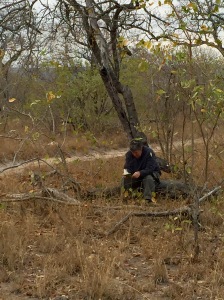
There are incredible benefits of sit spots. Emptying the mind calms the soul. Listening to nature’s symphony strengthens the senses and appreciation of the small things that live and move around us – and that we are a part of. Even though we were focused on awareness, and our two tasks, we also found ourselves thinking a little about family and friends back home. As days pass, we discover the little jewels that are often taken for granted at home. These small wonders aren’t always available where we are. Ice, for example, is greatly missed among the group. Carmen misses his girlfriend, Belle, most of all. Sam, along with the majority, misses water that tastes “good” (or differently from the…unique, mineral-rich, water of South Africa). Madeline can’t decide if she longs more for the company of her boyfriend, Tyler, or French fries.
The point is, although we are busy and enthusiastically fending off wild animals (mostly the vervet monkeys that steal our apples in camp) and dodging thorn bushes with each step or turn of the wheels, we haven’t forgotten home and are even more grateful for what the people supporting us back in the USA. So, to all curious and eager friends, family, and loved ones, please know we are thinking of you. You are special, you are missed, and you are loved.
Edited by Kersey Lawrence
